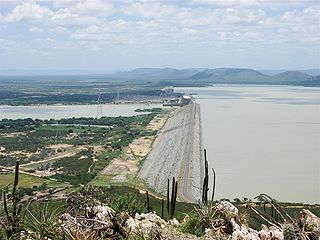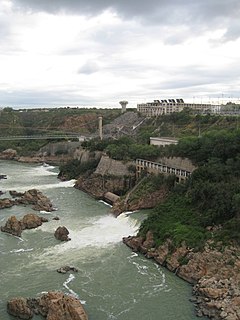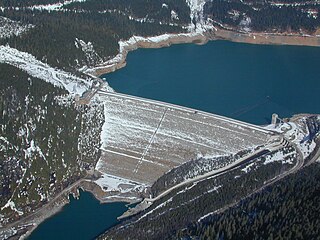
The Kariba Dam is a double curvature concrete arch dam in the Kariba Gorge of the Zambezi river basin between Zambia and Zimbabwe. The dam stands 128 metres (420 ft) tall and 579 metres (1,900 ft) long. The dam forms Lake Kariba, which extends for 280 kilometres (170 mi) and holds 185 cubic kilometres (150,000,000 acre⋅ft) of water.

Penápolis is a municipality in the state of São Paulo, Brazil. The population is of 58,510 inhabitants (IBGE/2010). The city has an area of 710.8 km².
Burrinjuck Power Station is a hydroelectric power station at Burrinjuck Dam, New South Wales, Australia. Burrinjuck has three turbines with a total generating capacity of 28 megawatts (38,000 hp) of electricity.

Run-of-river hydroelectricity (ROR) or run-of-the-river hydroelectricity is a type of hydroelectric generation plant whereby little or no water storage is provided. Run-of-the-river power plants may have no water storage at all or a limited amount of storage, in which case the storage reservoir is referred to as pondage. A plant without pondage is subject to seasonal river flows, thus the plant will operate as an intermittent energy source. Conventional hydro uses reservoirs, which regulate water for flood control and dispatchable electrical power.

The Billings Reservoir is the largest reservoir in São Paulo, Brazil, covering a total of 127 km2. It is named after Asa White Kenney Billings, the American hydroelectric engineer who was instrumental in building it. The Portuguese word represa also means "dam".

The Sobradinho Dam is a large hydroelectric dam built on the São Francisco River in Sobradinho, in the state of Bahia of Brazil. Completed in 1982, the dam generates power by utilizing six 175 megawatts (235,000 hp) Francis turbine-generators, totalling the installed capacity to 1,050 megawatts (1,410,000 hp).

The Ilha Solteira Dam is an embankment dam on the Paraná River near Ilha Solteira in São Paulo, Brazil. It was constructed between 1967 and 1973 for hydroelectric power production, flood control and navigation.

The Xingó Dam is a concrete face rock-fill dam on the São Francisco River on the border of Alagoas and Sergipe, near Piranhas, Brazil. The dam was built for navigation, water supply and hydroelectric power generation as it supports a 3,162 megawatts (4,240,000 hp) power station. It was constructed between 1987 and 1994 and the last of its generators was commissioned in 1997. In Portuguese, the dam is called the Usina Hidrelétrica de Xingó.

The Paulo Afonso Hydroelectric Complex, also known as the Paulo Afonso Complex, is a system of three dams and five hydroelectric power plants on the São Francisco River near the city of Paulo Afonso in Bahia, Brazil. The complex exploits an 80-metre (260 ft) natural gap on the river, known as the Paulo Afonso Falls. Constructed in succession between 1948 and 1979, the dams support the Paulo Afonso I, II, III, IV and Apollonius Sales (Moxotó) power plants which contain a total of 23 generators with an installed capacity of 4,279.6 megawatts (5,739,000 hp).

The Governor Ney Braga de Barros Hydroelectric Plant, formerly known as Segredo, is a dam and hydroelectric power plant on the Iguazu River near Segredo in Paraná, Brazil. It is the fourth dam upstream of the Iguazu Falls and was constructed between 1987 and 1991 while being inaugurated in 1992. The power station has a 1,260 megawatts (1,690,000 hp) capacity and is supplied with water by a concrete face rock-fill embankment dam.

The Engineer Souza Dias Dam, formerly known as the Jupiá Dam is an embankment dam on the Paraná River near Três Lagoas in Mato Grosso do Sul, Brazil. It was constructed for hydroelectric power production, flood control and navigation. Studies on the dam and power plant began in 1951 which recommended the dam along with the Ilha Solteira Dam. The dam was inaugurated in 1968 and its generators were commissioned between 1969 and 1974.

The Água Vermelha Dam is an embankment dam on the Grande River near Iturama in Minas Gerais/São Paulo, Brazil. It was constructed for hydroelectric power production and flood control. Construction on the dam began in 1973 and it was completed and operational by 1978. The last generators were operational in 1979.

The São Simão Dam is an embankment dam on the Paranaíba River near São Simão in Goiás/Minas Gerais, Brazil. It was constructed for hydroelectric power production and flood control. The dam was completed in 1978 and all generators were operational by 1979. In 1977, the first use of roller compacted concrete in Brazilian dam construction occurred on the São Simão.

The Emborcação Dam, also known as Theodomiro Santiago, is an embankment dam on the Paranaíba River near Araguari in Minas Gerais, Brazil. It was constructed for hydroelectric power production and flood control.

The Teles Pires Dam is a run-of-the-river hydroelectric dam on the Teles Pires River, 330 km (205 mi) upstream of the confluence with the Tapajós river, on the border of the Brazilian states of Mato Grosso and Pará. The 80 metres (260 ft) dam impounds a 150 square kilometres (58 sq mi) reservoir, 84% in Mato Grosso state and 16% in Para state.

Irapé Dam, the tallest dam in Brazil, is an embankment dam on the Jequitinhonha River in the state of Minas Gerais. It is on the border of Berilo and Grão Mogol districts, about 26 kilometres (16 mi) west of Virgem da Lapa. The dam was constructed between 2002 and 2006 for the purpose of hydroelectric power generation.

The Três Irmãos Dam is an embankment dam with gravity sections on the Tietê River in Pereira Barreto of São Paulo state in Brazil. The dam is about 28 kilometres (17 mi) upstream of the river's confluence with the Paraná River. It supports the largest hydroelectric power station on the river with an installed capacity of 807.5 megawatts (1,082,900 hp). The dam was completed in 1991 and the five 161.5 megawatts (216,600 hp) Francis turbine-generators were commissioned between November 1993 and January 1999. It is owned and operated by Companhia Energética de São Paulo (CESP). The dam also provides for navigation with two ship locks.

The Colíder Dam is a rock-fill dam with an asphalt-concrete core, currently under construction on the Teles Pires river about 40 km (25 mi) southeast of Colíder in the state of Mato Grosso, Brazil. The dam's hydroelectric power stations will have 3 turbines each 115 MW resulting in a total installed capacity of 306.9 MW. Construction on the run-of-the-river type station was initiated in May 2011, and is expected to be operational in 2015.

The Cachoeira do Cai Dam is a planned hydroelectric dam on the Jamanxim River in the state of Pará, Brazil, with a capacity of 802 megawatts (1,075,000 hp).

The Jardim do Ouro Dam is a proposed hydroelectric dam on the Jamanxim River in the state of Pará, Brazil. The dam would have a 42,600 hectares reservoir and capacity of 227 megawatts (304,000 hp). It has not been studied on detail due to relatively low return on investment compared to other projects in the region.













